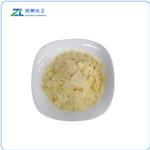Chemical Properties
Light Tan Cyrstalline Solid
Uses
3-Hydroxy-4-methoxybenzaldehyde was used as starting reagent during the two-step stereoselective synthesis of the anticancer drug (
Z)-combretastatin A-4 and glycitein synthesis.
Application
Isovanillin is a kind of fragrance and isomer of vanillin. it has unique properties than vanillin, its fragrance can change with the change of ambient temperature, so it is especially suitable for special cosmetics and some special fragrance industries. Isovanillin is a selective inhibitor of aldehyde oxidase. It is not a substrate of that enzyme, and is metabolized by aldehyde dehydrogenase into isovanillic acid, which could make it a candidate drug for use in alcohol aversion therapy.
Preparation
Synthesis of isovanillin: 4-Hydroxybenzaldehyde is used as raw material, firstly react with bromine to obtain 3-bromo-4-hydroxybenzaldehyde, then react with methyl iodide to obtain 3-bromo-4-methoxybenzaldehyde, and then hydrolyzed under the action of sodium hydroxide and cuprous chloride to produce isovanillin. The yield was 64.1%.
Definition
ChEBI: Isovanillin is a member of the class of benzaldehydes that is 4-methoxybenzaldehyde substituted by a hydroxy group at position 3. It is an inhibitor of aldehyde oxidase. It has a role as an EC 1.2.3.1 (aldehyde oxidase) inhibitor, a plant metabolite, an antidiarrhoeal drug, an antifungal agent, a HIV protease inhibitor and an animal metabolite. It is a member of phenols, a monomethoxybenzene and a member of benzaldehydes.
Synthesis Reference(s)
The Journal of Organic Chemistry, 45, p. 1596, 1980
DOI: 10.1021/jo01297a010
General Description
3-Hydroxy-4-methoxybenzaldehyde on condensation with furan-2-carboxylic acid hydrazide and thiophene-2-carboxylic acid hydrazide yields Schiff-bases. It undergoes condensation reaction with1-azabicyclo[2.2.2]octan-3-one to give (
Z)-2-(3-hydroxy-4-methoxybenzylidene)-1-azabicyclo[2.2.2]octan-3-one.
Flammability and Explosibility
Not classified
target
5-HT Receptor | AChR
Source
Isovanillin is a natural product found in many plant species like Pluchea sagittalis, Pycnocycla spinose, Mondia whitei, Benincasa hispida, Arum Palaestinum, Thalictrum przewalskii, Valeriana officinalis var. latifolia[1].
Purification Methods
Crystallise isovaniline from H2O or *C6H6. The oxime has m 147o. [Beilstein 8 IV 1764.]
References
[1] Ana C. de Carvalho . “Understanding the cytotoxic effects of new isovanillin derivatives through phospholipid Langmuir monolayers.” Bioorganic Chemistry 83 (2019): Pages 205-213.
[2] V. Balachandran , K. Parimala. “Vanillin and isovanillin: Comparative vibrational spectroscopic studies, conformational stability and NLO properties by density functional theory calculations.” Spectrochimica Acta Part A: Molecular and Biomolecular Spectroscopy 95 (2012): Pages 354-368.





